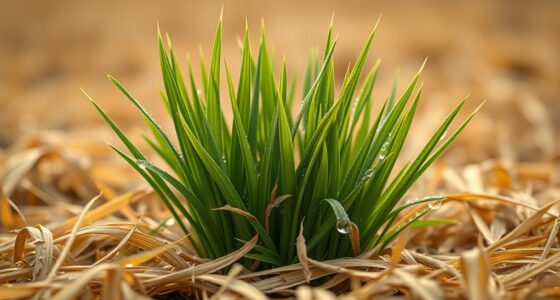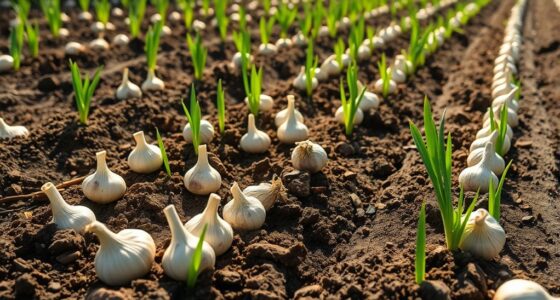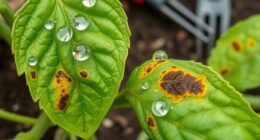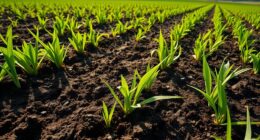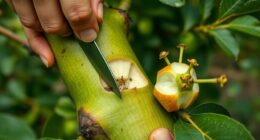To prevent crop diseases, start by understanding common threats and implementing effective management strategies, like crop rotation and regular inspections. Collaborate with agricultural advisors for tailored advice and utilize innovative tools such as the PlantwisePlus toolkit to enhance resilience. Maintain strict sanitation practices and monitor environmental conditions to further mitigate risks. By building strong, healthy fields today, you'll guarantee better yields tomorrow. Discover additional tips and resources to optimize your farming practices.
Key Takeaways
- Implement crop rotation to disrupt pathogen cycles and enhance soil health, boosting yields by up to 30%.
- Conduct regular inspections and monitoring to catch early signs of diseases and maintain healthy fields.
- Utilize clean seeds and practice strict sanitation to prevent the introduction and spread of new pathogens.
- Leverage digital tools like PlantwisePlus for tailored pest management recommendations and timely interventions.
- Educate yourself on pest identification and sustainable management strategies to promote awareness and best practices within the farming community.
Understanding Common Crop Diseases

Understanding common crop diseases is fundamental for any farmer aiming to protect their yield. Major food crops can lose 21% to 30% of their yield due to pests and diseases, underscoring the need for effective disease management.
Climate change worsens this situation, as increased rainfall spreads airborne pathogens and warmer temperatures trigger earlier pathogen outbreaks. Early detection and surveillance are essential for preventing rapid disease spread across borders.
By staying informed about plant diseases, you can act quickly and minimize losses. Integrated research fosters collaboration among scientists to develop innovative solutions that address emerging threats.
Ultimately, protecting your crops helps guarantee food security for everyone, making it imperative to prioritize understanding these challenges.
Implementing Effective Management Strategies
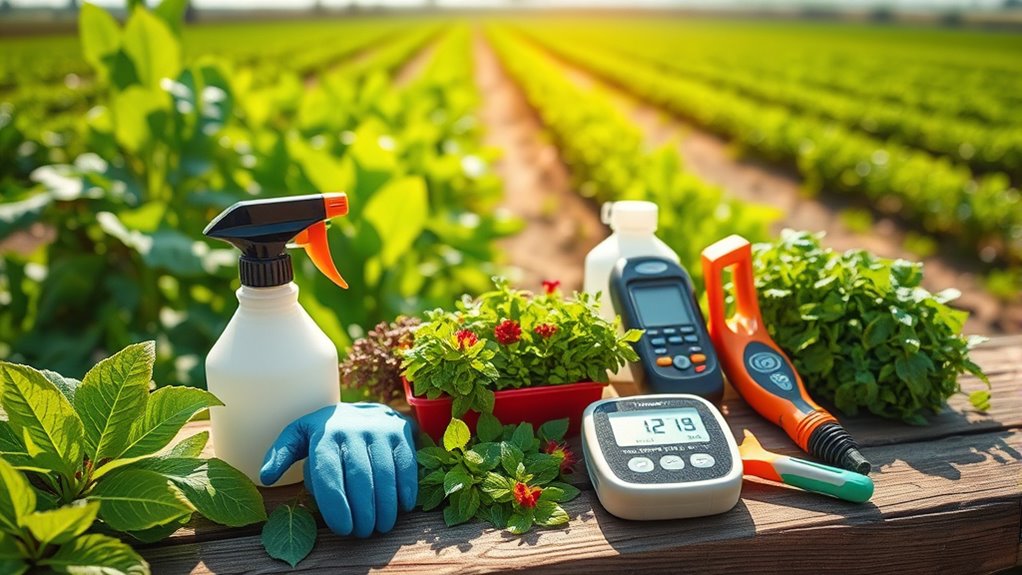
To effectively manage crop diseases, you'll want to focus on crop rotation techniques and consistent disease monitoring practices.
By alternating crop families, you can disrupt pathogen cycles and enhance soil health.
Additionally, regular inspections will help you catch any issues early, keeping your fields healthy and productive.
Crop Rotation Techniques
Crop rotation techniques can greatly enhance your farming practices by disrupting the life cycles of pests and diseases. By alternating different crop families, you can reduce disease buildup and improve soil health. A well-planned rotation schedule boosts nutrient management and crop compatibility, leading to healthier plants and increased yields—up to 30%! This approach also minimizes reliance on chemical inputs, fostering sustainable farming.
| Crop Family | Nutrient Requirements | Planting Schedule |
|---|---|---|
| Legumes | Nitrogen-fixing | Early Spring |
| Brassicas | High in Nitrogen | Late Spring |
| Grains | Moderate Nutrients | Late Summer |
| Root Vegetables | Varies by type | Early Summer to Fall |
Utilizing these strategies, you can enhance pest management and guarantee effective harvesting.
Disease Monitoring Practices
While effective disease management is essential for healthy crops, implementing robust monitoring practices can make all the difference.
Start by conducting weekly inspections of your crops to guarantee early detection of any diseased plants. This timely approach is vital to prevent spread.
Utilize technology, like electronic sensors, for rapid detection of plant pathogens, allowing you to respond swiftly to potential outbreaks.
Engage in crop rotation to manage pathogen populations effectively and reduce the risk of disease buildup.
Don't forget to collaborate with local extension services for ongoing support and best practices.
Finally, maintain strict sanitation by regularly washing your tools and equipment to prevent spreading diseases from infected fields to healthy plants.
The Importance of Preventative Practices

Preventative practices are vital for farmers aiming to safeguard their crops against diseases. By implementing effective strategies, you can greatly reduce disease pressure and enhance overall plant health.
Regular monitoring of environmental conditions is essential since factors like temperature and moisture can lead to outbreaks. Engaging in education on disease management keeps you informed about best practices and emerging threats.
Utilizing clean seeds and treating saved seeds with hot water helps prevent introducing new pathogens into your crops. Additionally, collaborating with local extension services provides you with valuable resources and ongoing support.
Collaborating With Agricultural Advisors

Working alongside agricultural advisors can greatly boost your understanding of pest and disease management strategies, ultimately protecting your crops from potential yield losses.
By collaborating with these experts, you gain access to tailored recommendations that consider your local conditions and challenges. Agricultural advisors utilize digital tools like the PlantwisePlus Knowledge Bank to provide essential pest management information.
Collaborating with agricultural advisors offers personalized pest management solutions tailored to your unique local conditions.
Engaging with them also allows you to implement sustainable practices that enhance crop resilience while reducing reliance on harmful pesticides. Furthermore, their training on pest identification is significant for timely interventions, minimizing impacts on crop health.
This support is especially beneficial for smallholder farmers and rural women, who often face barriers to traditional extension services.
Utilizing Innovative Resources and Technologies
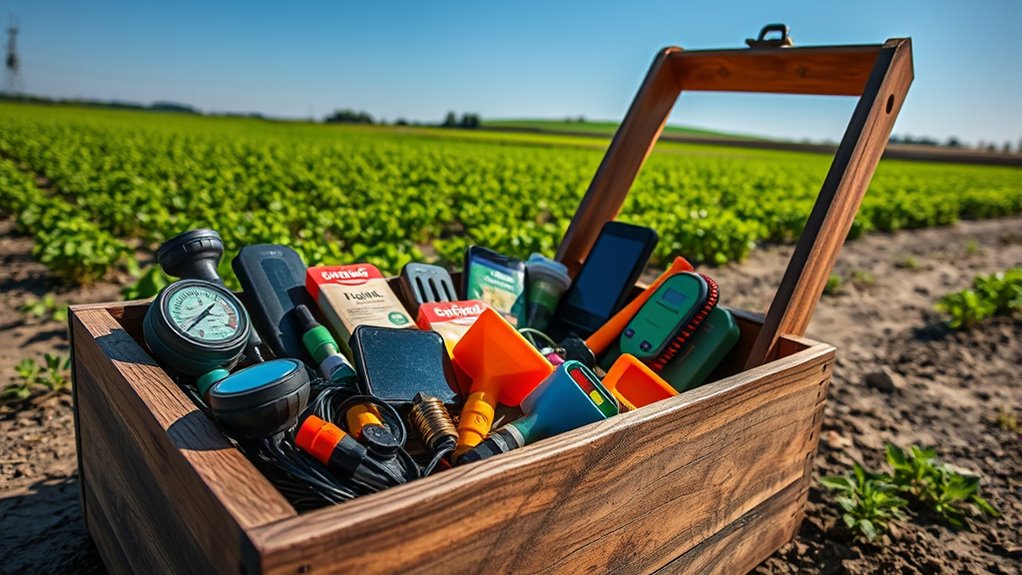
As you seek to protect your crops from diseases, utilizing innovative resources and technologies can make a significant difference in your farming practices.
Tools like the PlantwisePlus toolkit offer valuable insights into pest management, reducing crop losses by up to 40%.
With the Crop Sprayer App, you can optimize pesticide application, ensuring efficient use of crop protection tools while minimizing environmental impact.
The Fertilizer Optimizer Tool aids in nutrient application, essential for preventing disease outbreaks.
Additionally, the CABI BioProtection Portal promotes biological pest control, supporting sustainable practices that enhance crop resilience.
Enhancing Crop Health Through Sustainable Practices

To enhance crop health, you can adopt sustainable farming techniques that promote resilience and reduce disease risks.
Crop rotation is one effective method that not only breaks disease cycles but also improves soil health.
Sustainable Farming Techniques
Sustainable farming techniques are vital for enhancing crop health and preventing diseases. By implementing practices like crop rotation, you can disrupt the lifecycle of pests and diseases, promoting healthier crops.
Utilizing mulch conserves soil moisture and prevents soil-borne pathogens from splashing onto your plants during rainfall. Integrating drip irrigation minimizes water splashing on leaves, greatly reducing the risk of fungal infections.
Additionally, maintaining grassy walkways between plots helps prevent the spread of water-borne diseases by controlling water movement across fields. Regularly inspecting for diseased plants and promptly removing infected specimens is essential for pathogen prevention, ensuring that your crops thrive. Together, these sustainable farming methods improve soil health and contribute to the overall resilience of your farm.
Furthermore, prioritizing personal and community resilience in your farming practices can enhance your ability to withstand unforeseen challenges and ensure long-term success.
Crop Rotation Benefits
Implementing sustainable farming techniques like crop rotation offers significant benefits for enhancing crop health.
By rotating different crop families, you can reduce disease buildup and disrupt the life cycles of pests and pathogens, leading to increased yield stability.
Crop rotation improves soil fertility and structure, resulting in healthier plants and a potential 10-30% increase in yields compared to monocropping.
Additionally, it minimizes the need for chemical inputs, lowering your production costs and lessening environmental impacts.
Regularly changing crops also enhances biodiversity in the soil, fostering a resilient agroecosystem that can better withstand pests and diseases.
Embrace crop rotation, and you'll see the positive effects on your farm's productivity and sustainability.
Integrated Pest Management
While managing pests might seem challenging, Integrated Pest Management (IPM) offers a practical approach that enhances crop health through sustainable practices.
By incorporating crop rotation, you disrupt pest populations and reduce their buildup. Using resistant crop varieties can also decrease the prevalence of pests, leading to higher yields while minimizing reliance on chemical tools.
Regular monitoring and scouting for pests will help you identify outbreaks early, allowing for timely interventions and preventing costly crop losses.
Additionally, education and training in pest identification and management strategies empower you to implement effective IPM practices.
Building Resilience Against Future Disease Outbreaks

As global plant disease outbreaks become more frequent, it is crucial to build resilience against future challenges. Investing in technology and tools for early detection and surveillance can dramatically improve crop production. Collaborating with experts in climate, agriculture, and health guarantees a holistic approach to managing pests and diseases.
| Strategy | Impact on Resilience |
|---|---|
| Predictive Modeling | Enhances early detection |
| Data Analytics | Improves response time |
| Climate Data Integration | Forecasts disease spread |
| Expert Collaboration | Develops effective strategies |
| Investment in Research | Strengthens food security |
Frequently Asked Questions
How Do Farmers Prevent Disease?
Farmers prevent disease by implementing several key strategies.
You can start by using clean seeds and treating them to eliminate pathogens. Practicing good sanitation, like washing your tools and boots, minimizes the risk of spreading diseases.
Crop rotation with different plant families enhances soil health and reduces disease buildup. Regularly inspecting your plants allows for early detection, while using mulch and drip irrigation helps keep soil pathogens off your crops.
How Do Most Farmers Currently Protect Their Crops From Bugs Weeds and Disease?
Most farmers protect their crops from bugs, weeds, and diseases by using a mix of chemical pesticides and traditional practices.
You might apply herbicides like glyphosate to manage aggressive weeds or rely on manual weeding to reduce chemical use.
Embracing integrated weed management strategies can also help, combining chemical and mechanical methods.
Additionally, crop rotation and sanitation practices, like using clean seeds, play an essential role in maintaining plant health and preventing disease spread.
How Can We Reduce Crop Disease?
To reduce crop disease, you can start by implementing crop rotation to disrupt pathogen cycles.
Use clean seeds and treat saved seeds with hot water to avoid introducing new pathogens.
Regularly inspect your fields for any signs of disease and act quickly.
Maintain proper sanitation by washing your tools and boots after working in affected areas.
Finally, enhance your plants' health by monitoring environmental conditions and using cultural methods to minimize disease pressure.
How a Farmer Can Reduce the Spread of a Disease Through Their Crops?
You might think it's impossible to completely eliminate crop diseases, but you can greatly reduce their spread.
Start by washing your boots and tools after working in infected areas to prevent transferring pathogens. Regularly inspect your plants, removing any signs of disease immediately.
Use clean seeds and consider treating them with hot water. Crop rotation and managing weeds will also help eliminate disease hosts and improve your overall crop health.
Conclusion
In the battle against crop diseases, think of your farm as a fortress. Just as a knight sharpens their sword and fortifies their castle, you can arm yourself with knowledge and tools. Remember the 30% yield loss farmers faced last year due to unchecked diseases? By embracing proactive measures and sustainable practices, you can shield your crops and guarantee a bountiful harvest. Together, let's turn your farm into a thriving stronghold against the threats of tomorrow.



